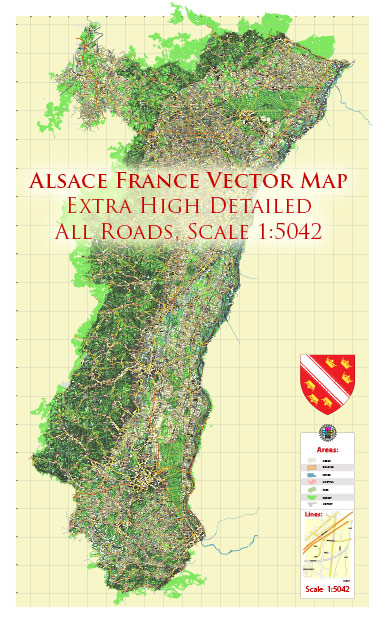Road System of Alsace France
Alsace, located in northeastern France, has a well-developed road system that provides efficient transportation throughout the region. Here is an overview of the road system in Alsace:
Highways: Alsace is served by major highways that connect it to other regions of France and neighboring countries. The A35 autoroute is the main highway running through Alsace, connecting Strasbourg, the region’s capital, to Mulhouse in the south. This highway is an essential route for both local and long-distance travel. The A4 autoroute, also known as the “Autoroute de l’Est,” passes through the northern part of Alsace, connecting Strasbourg to Paris and eastern France.
National Roads: In addition to highways, Alsace is well-connected by a network of national roads, known as “routes nationales.” These roads, designated with an “N” followed by a number, provide links between major cities and towns within Alsace, as well as connections to neighboring regions. For example, the N83 connects Strasbourg to Colmar, while the N66 connects Mulhouse to the Vosges Mountains.
Regional and Departmental Roads: Alsace has a comprehensive network of regional and departmental roads, designated with a “D” followed by a number. These roads serve as a primary means of transportation within the region, connecting smaller towns, villages, and rural areas. They provide access to the region’s vineyards, picturesque villages, and natural attractions.
Tramway System: Strasbourg, the capital of Alsace, is renowned for its efficient public transportation system, including an extensive tramway network. The tramway system provides convenient and environmentally friendly transportation within the city and its surrounding areas. It is a popular mode of travel for both residents and tourists.
Road Safety: Road safety is a priority in Alsace, as it is in the rest of France. Speed limits are enforced, and it is crucial to adhere to traffic laws and regulations. Be aware of specific rules, such as carrying a warning triangle, reflective vests, and an alcohol breathalyzer in the car, which are mandatory in France.
Travel Information: When planning your journey in Alsace, it is advisable to check traffic conditions and any road closures or construction works beforehand. Websites such as Bison Futé (www.bison-fute.gouv.fr) and regional traffic centers provide up-to-date information on road conditions and real-time traffic updates.
The road system in Alsace ensures convenient access to its vibrant cities, charming villages, and beautiful countryside. Whether you are exploring the wine route, visiting historic sites, or enjoying the local gastronomy, the road network in Alsace facilitates travel and allows you to discover the region’s unique attractions.
Water Resources of Alsace France
Alsace is rich in water resources, including rivers, canals, and lakes. Here are some key features of the water resources in Alsace:
Rhine River: The Rhine River forms the eastern border of Alsace, separating France from Germany. It is one of Europe’s major waterways and plays a vital role in the region’s water resources. The river offers opportunities for shipping, transportation, and leisure activities such as boating and cruises.
Ill River: The Ill River is the primary river in Alsace, flowing through the region’s major cities, including Strasbourg, Colmar, and Mulhouse. The Ill River and its tributaries provide water for irrigation, industry, and municipal use. They also add to the scenic beauty of the region, with riverside paths and green spaces for recreational activities.
Canal System: Alsace is crisscrossed by a network of canals, which serve both practical and recreational purposes. The Canal du Rhône au Rhin connects the Rhône River in eastern France to the Rhine River, passing through Alsace. It allows for navigation, supporting commercial transportation of goods and facilitating tourism activities such as canal boat trips and cycling along the towpaths.
Lakes and Reservoirs: Alsace is home to several lakes and reservoirs that add to the region’s water resources and offer opportunities for outdoor activities. The Lac de Gérardmer and Lac de Longemer in the Vosges Mountains are popular destinations for swimming, boating, and fishing. The Lac du Ballon d’Alsace is another scenic lake surrounded by forested hills. These lakes provide natural habitats for wildlife and contribute to the region’s tourism industry.
Groundwater: Alsace has significant groundwater resources due to its geological composition, including porous limestone and sandstone formations. These underground water reserves are tapped for drinking water supply, agriculture, and industrial use. The region has implemented measures to protect and sustainably manage groundwater resources to ensure their long-term availability.
Water Management: Water resources in Alsace are managed by local authorities, water agencies, and environmental organizations. Their focus is on maintaining water quality, preserving aquatic ecosystems, and promoting sustainable water use. Water management practices aim to balance the needs of various sectors, such as agriculture, industry, and domestic consumption, while ensuring the conservation of water resources.
The water resources of Alsace, including rivers, canals, and lakes, contribute to the region’s natural beauty, recreational activities, and support various economic sectors. The region’s commitment to sustainable water management ensures the preservation and responsible use of these valuable resources.


 Author: Kirill Shrayber, Ph.D.
Author: Kirill Shrayber, Ph.D.